Akira Shimizu and Anti-Art Movement
A series of "Anti-Art" Movement, centering on expressions such as Assemblage, Installation and Happening, happened in Japan early 60's. @Shimizu began his career in this movement, in which Yomiuri Independent Exhibition had been played an important role.
gHan Geijutsu Undoh, the Ant-Art Movement, was named by an art critic Yoshiaki Tono who referred to Tetsumi Kudofs artwork that was exhibited in the Yomiuri Independent Exhibition.
hNeo Dadaism Organizersh and gHigh Red Centerh were well-kwon groups for their anti-art activities in the early 1960fs. Shimizu did not belong to these groups, but co-produced several events with the group members.
Neo Dadaism Organizers
This group was an avant-garde group formed in 1960 in Tokyo by 11 artists who participated in the 12th Yomiuri Independent Exhibition. They put on anarchism performances and events opposing the traditional art system and style in Japan.
For example, Ushio Shinohara made and exhibited 300 balloons shaped like jelly beans, and Masunobu Yoshimura marched in the center of Tokyo wrapped up in exhibition posters.
High Red Center
High Red Center was an avant-garde artist group organized in Tokyo in 1963 by Jiro Takamatsu, Genpei Akasegawa, and Natsuyuki Nakanishi. By performing Happenings, they posed the question to the society as to whether or not the performances were art. As a result, since the Tokyo Olympics were going to be held soon, their actions disturbed metropolitan Tokyo, where the police strengthened security.
By disguising themselves as public workers, they sometimes dressed like members of a secret organization and did gcleaning performancesh. Their aim was to turn their daily work into an art form. These events attracted both Japanese people and journalists of the day. They sometimes co-produced events with other artists who shared their concept.
Yomiuri Independent Exhibitions
Yomiuri Independent Exhibitions, organized by the newspaper company, Yomiuri Shimbun, were art exhibitions without competition and prizes. It started in 1949 and lasted until 1963. It gained popularity among young ambitious artists who had difficulties in finding their sponsors. The exhibitions became effective and were ways for the artists to become famous, and many anti-art artists participated in the exhibitions, especially between 1960 and 1963.
However, in December 1962 the Tokyo Metropolitan Art Gallery, where the exhibitions were held, enacted Exhibition Work Standards, and prohibited the following :
- those which made unpleasant and/or high frequency sounds
- those which produced bad smells or used materials which rotted easily
- those which used cutlery that could offend people
- those which made the spectators uncomfortable from a hygienic point of view
- those which used gravel or sand that scattered directly on the floor and could harm it
- those which hung directly from the ceiling.
The guidelines would indeed show what the exhibited artworks were like. The organizer did not want to get into trouble, and in 1964, decided to discontinue the exhibitions just before the 16th one.
Partially referenced to Wikipedia: Text of GNU Free Documentation License
Background of Anti-Art movement
* Dramatic change of values and education in their adolescence
It is interesting that most of the anti-art artists of the Neo Dadaism Organizers and the High Red Center members were born in the 1930fs and received their primary education before and after World War II. When they were in their early stage of primary school, Japan was a country of militarism and the education was so nationalistic. However, in 1945 after Japan surrendered to the Allied Powers, the education changed dramatically. The Japanese constitution was written under US supervision, and the people were liberated from the spell of nationalism.
In their adolescence, the anti-art artists had experienced a sudden change of values, and how difficult it is to describe their ambivalent feelings. It is certain that this motivated them to express something from within.
* Development of Mass media
With the development of industry and high economic growth after WWII, modern mass media system (television and journalism) also developed dramatically. The performances of the two groups attracted mass mediafs interests very much.
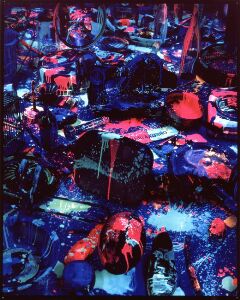
Black Light
In 1962 he exhibited Black Light, which is thought to be one of forerunners of gPsychedelic Arth. In "this work" phosphorescence paints are scattered on the daily@commodities, and when the black light (ultraviolet rays) is irradiated, the commodities emit richly colored light and are transfigured to totally different things ? shiny spectacle. He said that he tried erasing a fact by another fact, that is, to give it a dual meaning.
Also he said g it is not important for me to find the way only available in art to answer the question, however I am interested in finding art expression which is available in plural ways to answer the question. The boundary between false and truth, imitation and real thing cannot be defined. However, it certainly exists and I aim to remove the boundary as much as possible, to turn the false to the truth.h
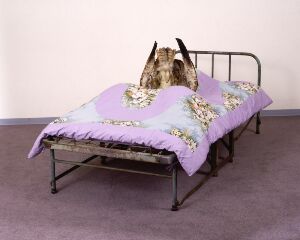
Recreation
In March and July 1963 he exhibited gRecreationh at the 14th Yomiuri Independent Exhibition and "Absent Room Event" held at Naika Gallery respectively. Naika Gallery was a rental gallery space that was used as a clinic of internal medicine officially, and it also became a good exhibition space for anti-art artists after Yomiuri Independent Exhibition was discontinued in 1963.
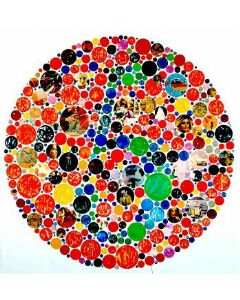
Color Blindness Test Chart
In September 1963 he exhibited gColor Blindness Test Chart No. 4 and No9h at Shell Art Exhibition and was awarded first prize. In this artwork series, each number chart was made of colorful dots and pictures (collage) cut in circle. The interesting material used is photographs and pictures of Playboy magazines.
He said g I aim to make clear the function and the purpose as much as possible. The reason I paint the work very colorful is to give this work a role like glight traph which attracts insects. I want the viewers to come into my plot. I aim to replace complex, nihilism confession and rebellion that are hidden in the contemporary social system with humorous but cold wisdom and device that can be found by the contemporary people. I want to keep finding the new way to prove that being utilized by something is utilizing it at the same time.
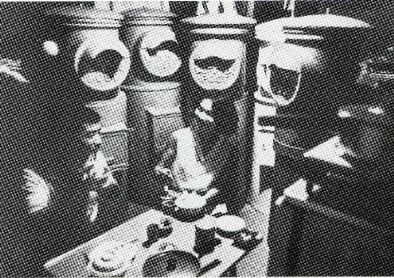 In March 1965 at the Tsubaki Gallery in Tokyo, he exhibited his "Mail Box" series called "Big Fight Exhibition". Shimizu made imitations of mail boxes as real as possible. One of the mail box sculptures was installed in front of the gallery, and many people who walked along the street dropped their letters into it. So, Shimizu actually had to go to a nearby mail box in order to mail them.
In March 1965 at the Tsubaki Gallery in Tokyo, he exhibited his "Mail Box" series called "Big Fight Exhibition". Shimizu made imitations of mail boxes as real as possible. One of the mail box sculptures was installed in front of the gallery, and many people who walked along the street dropped their letters into it. So, Shimizu actually had to go to a nearby mail box in order to mail them.
In the 1960fs, he continued to make as many sculptures as possible, and in the end, he and his wife had to eat in a room filled with them. He also performed an artistic event with them. He carried his post on his back and walked around the downtown area of Kawasaki, an industrial city adjacent to Tokyo.
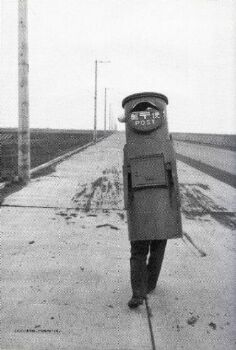
Walking with "Post" (1965)
His mail box sculptures were strongly related to his childhood memories. During World War II when he was 7, he experienced the bombing of Toyama city, his hometown located on the coast of the Sea of Japan. He remembered that after the city was bombed, in the devastated town, only the mail boxes existed.
Later in the 1990fs, he again chose the mail box as a motif. This time, they were split in half or twisted. Mail box is one of his important themes.
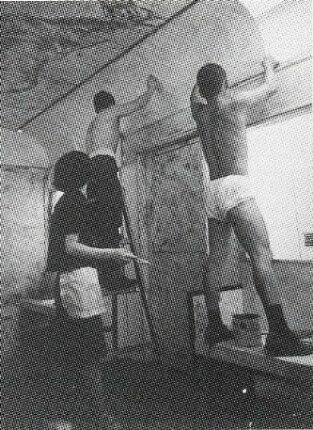
"Producing "Ms. Mary Ms. Mary Eventh with Ushio Shinohara(1967)
Ms. Mary Ms. Mary Event(Anti-Art Train Event) was co-produced by Ushio Shinohara and Nobuaki Kojima. Shinohara, born in 1932, is an avant-garde artist who organized Neo Dadaism Organizers in 1960 with other 10 members. He produced many anarchic artworks as well as practicing performances like boxing paintings that attracted many people's interets. In 1969, he went to New York, where he continues to live up until now.

© 2010 Akira Shimizu. All rights reserved.






